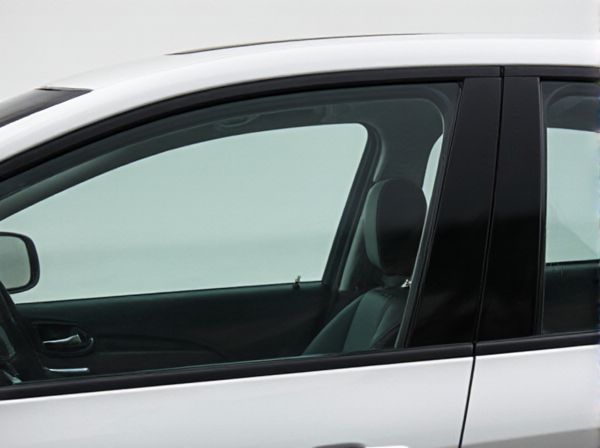
Photo illustration: Smart Glass Window vs Conventional Glass Window
Smart glass windows offer dynamic control over light and heat transmission, enhancing energy efficiency and privacy compared to conventional glass windows. Your indoor environment benefits from reduced glare and improved temperature regulation without the need for blinds or curtains. These advanced windows adapt to changing conditions, providing superior comfort and sustainability.
Table of Comparison
| Feature | Smart Glass Window | Conventional Glass Window |
|---|---|---|
| Transparency Control | Adjustable opacity via electric switch | Fixed transparency, no control |
| Energy Efficiency | Reduces heat and UV rays, lowers cooling costs | Limited insulation, higher energy loss |
| Privacy | Instant privacy on demand | No built-in privacy features |
| Cost | Higher initial investment | Lower upfront cost |
| Durability | Comparable to tempered glass | Standard glass durability |
| Maintenance | Requires electrical system upkeep | Minimal maintenance needed |
| Weight | Slightly heavier due to tech layers | Lighter, standard glass weight |
| Applications | Luxury and high-tech vehicles | Common in all vehicle types |
Introduction to Smart and Conventional Glass Windows
Smart glass windows utilize advanced technology such as electrochromic, thermochromic, or photochromic materials to adjust their transparency and control light and heat transmission automatically or on demand. Conventional glass windows are made from standard clear or tinted glass, providing basic visibility and minimal insulation without dynamic control features. The innovative properties of smart glass enhance energy efficiency and comfort, contrasting with the static and less adaptable nature of traditional glass panes.
How Smart Glass Windows Work
Smart glass windows utilize electrochromic, thermochromic, or photochromic technologies to adjust their transparency based on electrical, thermal, or light stimuli, respectively. Electrochromic smart glass changes opacity by applying a low-voltage electrical current that triggers ion movement within the glass layers, enabling tint modulation. This dynamic control improves energy efficiency, glare reduction, and privacy compared to conventional glass windows that remain static and passive in their light and heat transmission.
Conventional Glass Windows: Features and Limitations
Conventional glass windows are typically made from single or double-pane glass that provides basic insulation and natural light without energy efficiency controls. These windows allow unrestricted heat transfer, resulting in higher indoor temperature fluctuations and increased reliance on HVAC systems. Lack of glare reduction and UV protection contributes to interior fading and discomfort, limiting their suitability in modern energy-conscious building designs.
Energy Efficiency Comparison
Smart glass windows significantly outperform conventional glass windows in energy efficiency by dynamically controlling solar heat gain and reducing reliance on HVAC systems. They utilize electrochromic or thermochromic technology to adjust tint based on external conditions, leading to energy savings up to 30-50% in cooling and heating costs. Conventional glass windows lack this adaptive capability, resulting in greater energy loss and higher utility bills.
Cost Differences and Long-Term Value
Smart glass windows typically have a higher upfront cost compared to conventional glass windows due to advanced materials and technology integration, ranging from $50 to $100 per square foot versus $15 to $30 for traditional glass. Despite the initial investment, smart glass offers significant long-term value by reducing energy consumption through dynamic solar control, leading to potential utility savings of 20-30%. Conventional glass lacks adaptive features, often resulting in higher cooling and heating expenses, which can offset its lower initial price over time.
Privacy and Security Considerations
Smart glass windows enhance privacy by allowing users to switch from transparent to opaque states instantly, preventing unwanted visibility while maintaining natural light flow. Unlike conventional glass windows, which offer no dynamic control over transparency, smart glass reduces the need for curtains or blinds, minimizing security risks associated with manual window coverings. Furthermore, the advanced technology in smart glass often includes UV blocking and shatter-resistant features, providing superior security against intrusions and environmental damage.
Aesthetic and Design Flexibility
Smart glass windows offer superior aesthetic appeal with customizable opacity and color options that enhance modern architectural designs, whereas conventional glass windows provide limited design flexibility and rely primarily on static transparency. The ability of smart glass to switch between clear, tinted, or frosted states allows architects and interior designers to create dynamic, interactive environments tailored to changing light and privacy needs. Unlike traditional glass, smart glass integrates seamlessly with advanced building automation systems, supporting innovative design concepts without compromising visual appeal.
Installation and Maintenance Requirements
Smart glass windows require specialized installation involving electrical wiring and control systems, often necessitating professional expertise, whereas conventional glass windows involve straightforward fitting without electrical components. Maintenance for smart glass includes periodic inspections of electronic elements and cleaning with non-abrasive materials to prevent damage to the conductive layers, while conventional glass windows demand standard cleaning and occasional frame upkeep. The higher initial complexity and maintenance demands of smart glass contribute to increased long-term operational considerations compared to conventional glass windows.
Environmental Impact and Sustainability
Smart glass windows significantly reduce energy consumption by regulating heat and light transmission, leading to lower HVAC demands and decreased carbon emissions compared to conventional glass windows. Their ability to enhance natural daylight while minimizing UV exposure contributes to improved indoor environmental quality and prolonged building material lifespan. The use of electrochromic or thermochromic technologies in smart glass supports sustainable building practices by reducing reliance on artificial lighting and thermal insulation resources.
Choosing the Right Window for Your Needs
Smart glass windows offer dynamic light control and energy efficiency by adjusting tint based on sunlight, enhancing comfort and reducing cooling costs. Conventional glass windows provide a fixed transparency and are generally more affordable upfront, but lack the adaptive features of smart glass. Selecting the right window depends on factors like budget, energy savings priorities, privacy needs, and desired technological integration in your building.
 caratoz.com
caratoz.com